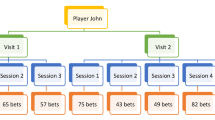Abstract
To understand some of the deviations from recommended optimal play in Blackjack, gamblers were considered to be decision makers who used decision rules to predict outcomes. The size of their wagers were used as an index of the confidence of these predictions. If this were the case, players' decisions would be affected by time pressure, short-term probability of winning, and their perceived control of outcomes. Players' wagering on a simulated game of Blackjack was examined to assess the feasibility of this approach. The computer simulation of Blackjack used simplified rules (no splitting, doubling down, insurance, etc.), and the probability of winning was controlled by the computer. Subjects could either choose whether they were dealt extra cards, or could bet upon “another player.” The “other player” was a computer algorithm that sat upon a total of fifteen. To examine effects of time pressure upon confidence of judgments, the time allowed to place a bet, and to choose extra cards, was manipulated. Twelve subjects played 20 hands under each of the experimental conditions. The mean amounts wagered, and players' choice of cards were both examined. The results suggested that deviations from optimal play can in part be understood in terms of players' decision processes, that are influenced by the time available to make a decision, the short-term probability of winning, and perceived control of outcomes; each factor may potentiate the effects of the others.
Similar content being viewed by others
References
Anderson, G., & Brown, R.I.F. (1984). Real and laboratory gambling, sensation-seeking and arousal.British Journal of Psychology, 75 401–410.
Baldwin, R., Cantey, W., Maisel, H., & McDermott, J. (1956). The optimum strategy in Blackjack.Journal of the American Statistical Association, 51 429–439.
Ben Zur, H. & Breznitz, S.J. (1981). The effect of time pressure on risky choice behavior.Acta Psychologica, 47 89–104.
Bond, N.A. (1974). Basic strategy and expectation in casino blackjack.Organisational Behaviour and Human Performance, 12 413–428.
Brown, B.R. (1988). Going on tilt: Frequent poker players and control. In W.R. Eadington (Ed.),Proceedings of the 7th International Conference on Gambling and Risk Taking. University of Nevada: Reno, Nevada.
Ceci, S.J. & Liker, J.K. (1986). A day at the races: A study of IQ, expertise, and cognitive complexity.Journal of Experimental Psychology: General, 115 255–266.
Cohen, L.J. (1979). On the psychology of prediction: Whose is the fallacy?Cognition, 7 385–407.
Epstein, R.A. (1967).The theory of gambling and statistical logic. New York: Academic Press.
Greenberg, J.S. (1985). Simulation and the casinos. In. W.R. Eadington (Ed.),The Gambling Studies: Proceedings of the Sixth National Conference on Gambling and Risk Taking Vol. 2. (pp. 147–182).
Griffin, P.A. (1986).The theory of Blackjack (revised and expanded). Davis, California: Faculty Publishing.
Keren, G. & Wagenaar, W.A. (1985). On the psychology of playing blackjack: Normative and descriptive considerations with implications for decision theory.Journal of Experimental Psychology: General, 114 133–158.
Koriat, A., Lichtenstein, S., & Fischhoff, B. (1980). Reasons for confidence.Journal of Experimental Psychology: Human Learning and Memory, 6 107–118.
Kusyszyn, I. (1984). The psychology of gambling.Annals of the American Academy of Political and Social Sciences, 474 133–145.
Lopes, L.L. (1981). Decision making in the short run.Journal of Experimental Psychology: Human Learning and Memory, 7 377–385.
Lopes, L.L. (1983). Some thoughts on the psychological concept of risk.Journal of Experimental Psychology: Human Perception and Performance, 9 137–144.
Pitz, G.F. (1970). On the processing of information: Probabilistic and otherwise.Acta Psychologica, 34 201–213.
Rosecrance, J. (1986). The sociology of casino gamblers.Nevada Public Affairs Review, 2 27–31.
Wagenaar, W.A., Keren, G., & Pleit-Kuiper, A. (1984). The multiple objectives of gamblers.Acta Psychologica, 56 167–178.
Author information
Authors and Affiliations
Additional information
The authors would like to acknowledge the assistance of Carl Waterman III, for his help with the graphics and timing routines used in the Blackjack program.
Rights and permissions
About this article
Cite this article
Phillips, J.G., Amrhein, P.C. Factors influencing wagers in simulated Blackjack. J Gambling Stud 5, 99–111 (1989). https://doi.org/10.1007/BF01019757
Issue Date:
DOI: https://doi.org/10.1007/BF01019757




